If you don’t have access to your own shiny server or database server, hosting exams may seem intriguing. A simple alternative to acquiring, setting up, and managing your own infrastructure is to use cloud-based hosting providers. This guide showcases how to use shinyapps.io for hosting the exam and AWS RDS for hosting the database. Of course there are numerous other hosting providers which may better suite your needs or preferences, and many of the steps outlined here can be easily translated to these other providers.
Important caveats when using hosting services such as shinyapps.io:
- Security: it is not safe to add exercise questions to exams hosted on shinyapps.io, as there is no way of preventing the user-code from accessing the exam document file (a learner could see the solutions). Even more concerning, learners could access the credentials used for the database connection!
- Costs: some of the services used in this guide may incur costs. shinyapps.io offers a free account which is sufficient for trying out exam documents, and may be enough to administer an exam to a small group of learners. The RDS service hosted by Amazon AWS also has a free tier program (for up to 1 year), which gives you access to a database for testing or few learners. If you need to provision for exams for a larger number of learners, the free services may not be sufficient. However, you can easily scale up the database and/or the shinyapps.io resources without having to redo the setup. Similarly, you can stop the database during times you don’t need it and you will not pay anything for running the database. If you are above the free tier usage limits for storage size, you would continue to pay for the storage. But it is very unlikely that you would come close to the free tier limits if you store only data from examinr exams.
The following guide explains how to use the free services provided by shinyapps.io and Amazon AWS and you will need
- an Amazon AWS account
- an account on shinyapps.io (a free account is sufficient for now)
-
pgAdmin 4 or the
psqlcommand line utility on your local computer - the RStudio IDE
The three steps covered in this guide are
- Setting up a database on AWS RDS.
- Preparing the exam document to use the new database.
- Publishing the exam to shinyapps.io.
Step 1: Setting up a database on AWS RDS
Log in to the Amazon AWS Management Console. Ensure you are operating in the AWS region your database should be hosted in (can be selected in the top right corner of the management console). This is relevant if you have to follow certain data privacy laws which mandate the location where data needs to be stored.
Step 1.1: Configure the cluster network
Step 1.1.1: Set up a VPC
Go to the service VPC to configure the “virtual private cloud” network. This is a “virtual network” in which the database server will be launched in.
- Click on Create VPC.
- Set the name of the VPC to something descriptive, e.g.,
examinr-db. - Use an IPv4 CIDR block of
172.31.0.0/16. - Click on Create VPC.
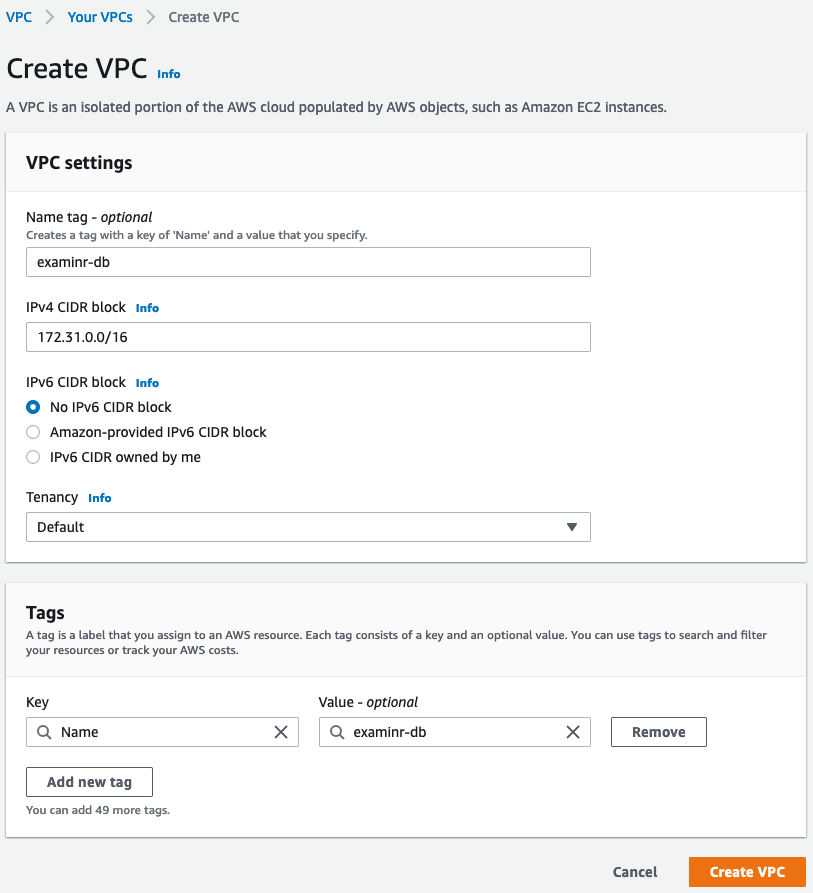
Step 1.1.2: Create a security group
Next you need to create a security group which specifies through what channels someone can access the server inside the VPC and also how the server inside the VPC may communicate with the outside.
- In the navigation on the left, click on Security Groups.
- Click on Create Security Group.
- Set a descriptive name for the security group, e.g.,
examinr-db-sg. - Add a description, e.g.,
Security group for the database cluster storing examinr exam data.. - Select the previously created VPC (
examinr-db). - Under Inbound rules click on Add rule.
- Under Type select PostgreSQL.
- Under Source select Anywhere. If you don’t want to restrict network access to your database, you can white-list only your local computer (by selecting My IP) and the the shinyapps.io network (see the official documentation for a list of IP addresses).
- The Outbound rules can be left as-is.
- Click on Create security group

Now you have defined a network which allows inbound traffic only to the database.
Step 1.1: Create a database instance
Go to the service RDS to create you database instance
- Click on Create database. Ensure again that you are in the correct region!
- Under Choose a database creation method, select Standard create.
- Under Engine options, select PostgreSQL as the engine type and leave the selected version.
- Under Templates, select Free tier.
- Under Settings, use a descriptive name for the DB
instance identifier, e.g.,
examinr-db. Leave the master username aspostgresand select Auto generate a password as this is the most secure option. Important: this is a very, very sensitive password and hence should be very complex. You will use this password only once and you can specify a new password in the AWS console if you forget it, so there is no need to make the password easy to memorize or anything. Anyone with this password can access all the exam data! - Leave the settings under DB instance size, Storage, and Availability & durability as they are. You can increase the instance size and storage size later when your database becomes a bottleneck for the exam (e.g., if your exam is used by > 20 learners at a time).
- Under Connectivity, select the following
- Select the VPC you created in Step 1.1.1.
- Under Public access, select Yes.
- Under Database authentication, select Password authentication.
- If you chose to automatically generate the password, the View credential details button appears on the Database page. To view the password for the DB instance, click on View credential details. Take note of the password as you cannot view it again (but you can change the master password anytime in the AWS console).
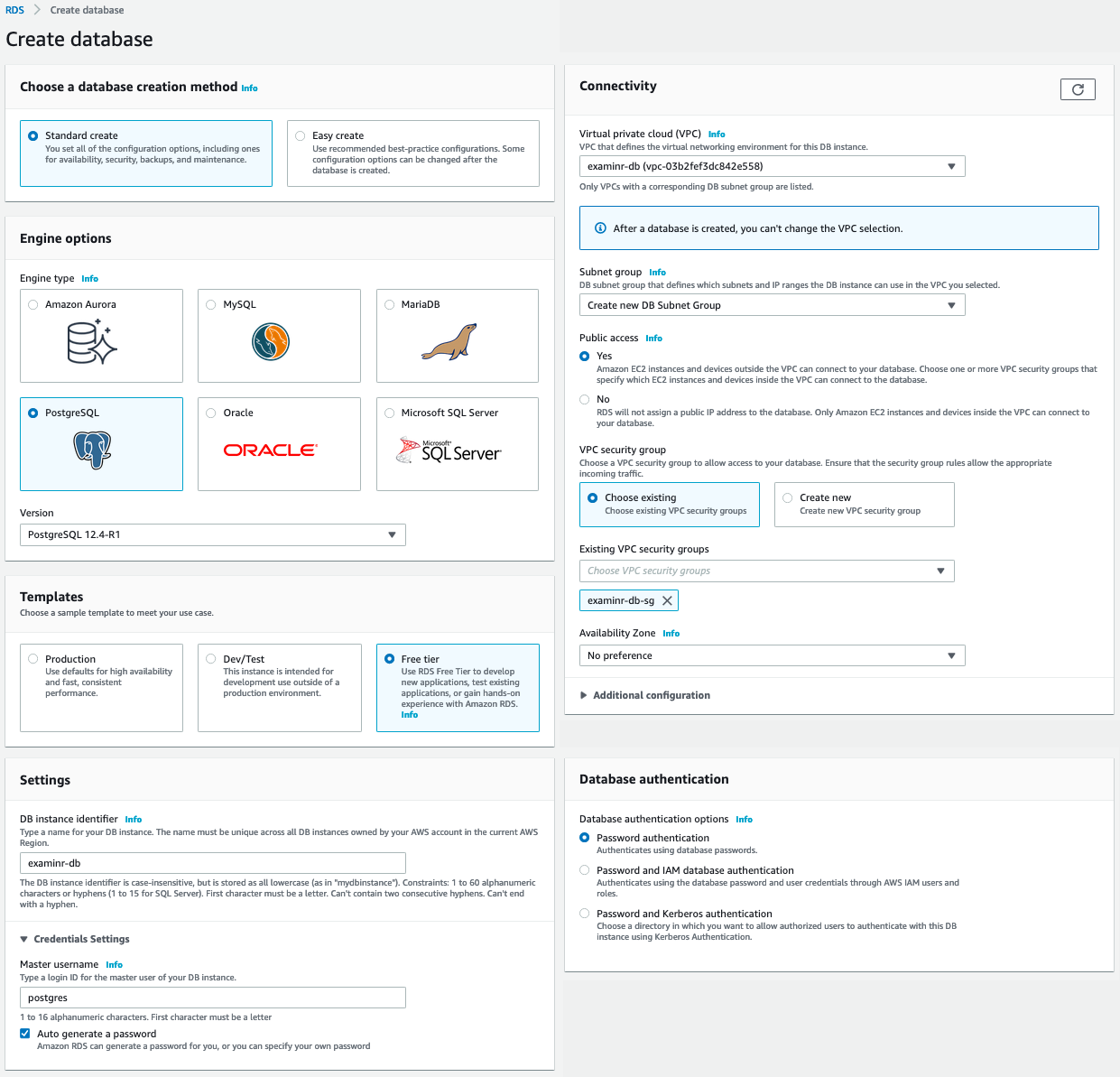
The new database will take a few minutes to be created and started.
Step 1.2: Create a database on the DB instance
Once the new database is launched, click on the DB identifier
examinr-db to get the summary information for the new
database. Locate the endpoint URL:

If you use pgAdmin 4, you need to use the information from the summary page to set up the connection to the DB instance. Start pgAdmin 4, click on Object > Create > Server, and enter the details for the server connection, as shown in the figure below (replace DB_instance_endpoint with the endpoint URL of the DB instance) Click on Save.
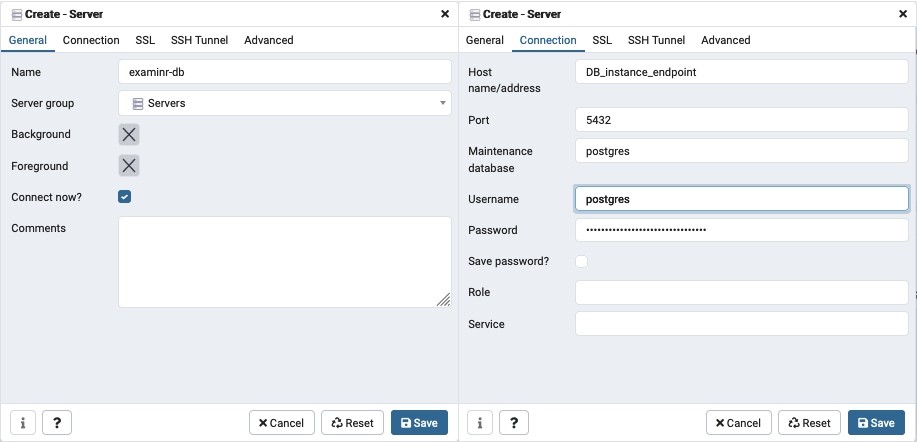
When connected to the DB instance, you need to create a database for
the exam data. In pgAdmin 4, click on Object >
Create > Database and enter examinr as
Database name. Click on Save.
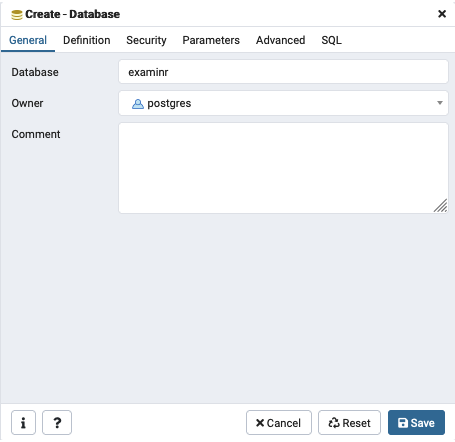
If you have the psql command line utilities installed,
you can also run the following command in your shell (replace
DB_instance_endpoint with the endpoint URL of the DB
instance):
Step 1.3: Create a database role
Once the database is created, you need to create a role, i.e., the DB user used for connecting to the database from the exam document).
If you use pgAdmin 4, click on Object > Create > Login/Group Role:
- Under General, enter the name for the role, e.g.,
examinr. - Under Definition, enter the password for the role.
- Under Privileges, set Can login? to Yes and leave the others as No.
Click on Save.
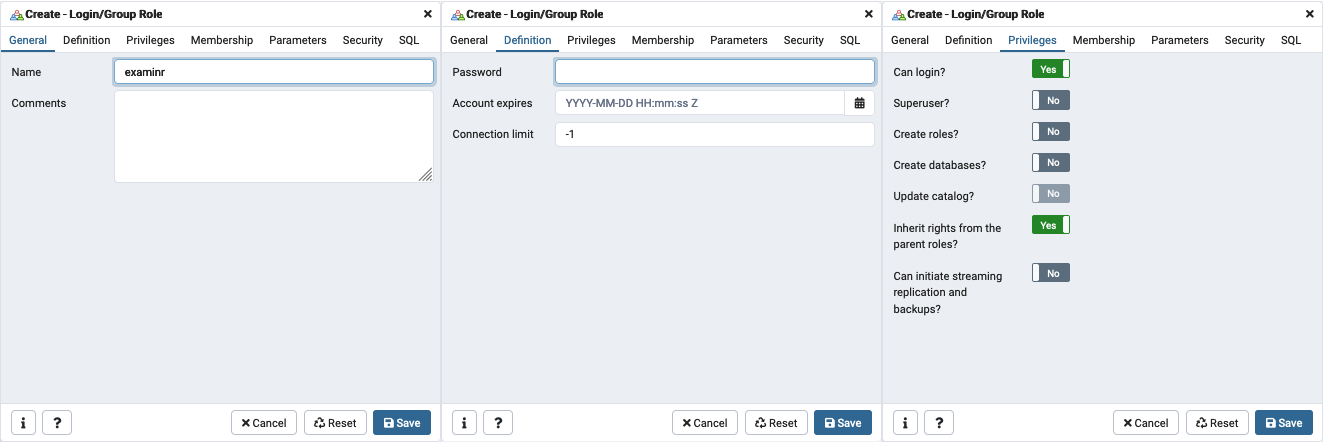
If you have the psql command line utilities installed,
you can add the role by starting the psql shell with
(replace DB_instance_endpoint with the endpoint URL of the DB
instance):
This opens a shell where you can enter SQL and psql
commands:
psql (12.1, server 12.4)
SSL connection (protocol: TLSv1.2, cipher: ECDHE-RSA-AES256-GCM-SHA384, bits: 256, compression: off)
Type "help" for help.
examinr=>The role examinr can be created created by running the
following two commands:
CREATE ROLE examinr WITH LOGIN NOSUPERUSER NOCREATEDB NOCREATEROLE;
\password examinrStep 1.4: Create the tables
Open a query tool in pgAdmin 4 for the examinr database
by clicking on the examinr database and then using right-click
on the database to start the query tool:
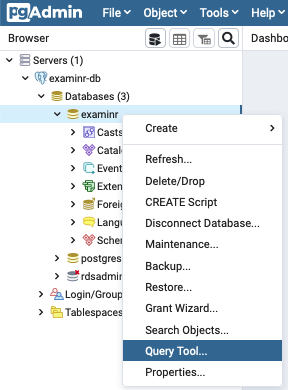
If using the psql command line utilities, connect to the
examinr database with:
Either in the query tool (if using pgAdmin 4) or in the
psql shell, run the following SQL commands:
CREATE TABLE attempts (
attempt_id uuid PRIMARY KEY,
user_id character varying NOT NULL,
exam_id character varying NOT NULL,
exam_version character varying NOT NULL,
started_at double precision NOT NULL,
seed integer NOT NULL,
user_obj text NOT NULL,
finished_at double precision,
points text
);
CREATE INDEX attempts_index ON attempts (user_id, exam_id, exam_version);
CREATE TABLE section_data (
id serial PRIMARY KEY,
attempt_id uuid NOT NULL REFERENCES attempts (attempt_id)
ON DELETE CASCADE ON UPDATE CASCADE,
section character varying NOT NULL,
saved_at double precision NOT NULL,
section_data text
);
CREATE INDEX section_data_index ON section_data (attempt_id, section);
GRANT CONNECT ON DATABASE examinr TO examinr;
GRANT SELECT, INSERT, UPDATE ON attempts TO examinr;
GRANT SELECT, INSERT, DELETE ON section_data TO examinr;
GRANT USAGE ON section_data_id_seq TO examinr;Now your database is all set up and ready to be used from the exam document.
Step 2: Using the new database in an exam
You can now create an exam which uses the newly created database. In RStudio, click on File > New File > R Markdown…. Select From Template and select the Exam template. Enter the name of the exam document and where to save the exam.
You would go about creating the exam as usual, but you also need to give the exam document the connection credentials (i.e., the name and password for the role you created before). The easiest way is to create the file .Renviron in the directory of the exam document. The contents of this file would be
PGUSER='examinr'
PGPASSWORD='password_for_database_user_examinr'You need to replace password_for_database_user_examinr with
the actual password you entered when creating the database role
examinr. For more control, you could use the config
package.
Important: The file is readable by the user-code from exercises and hence would expose your database credentials. Currently, it is not safe to add exercise questions to exams hosted on shinyapps.io, as there is no way of preventing the user-code from accessing the credentials file.
Now you are ready to set up the connection with the database in the exam document. The connection is established in a code chunk with server-start context, as in the following sample exam.
---
title: "Exam Using AWS RDS"
lang: en-US
output:
examinr::exam_document:
id: exam-using-aws-rds
version: 0.1
progressive: no
feedback: immediately
runtime: shiny_prerendered
---
```{r setup, include=FALSE}
# Load the package
library(examinr)
knitr::opts_chunk$set(echo = FALSE)
```
```{r, context="server-start"}
library(pool)
library(RPostgres)
# Establish a pool of connections to the database.
# User-name and password are taken from environment variables
# PGUSER and PGPASSWORD, respectively.
db_con <- dbPool(drv = Postgres(),
dbname = "examinr",
host = "db-examinr-testing.cwdxbpewlsih.ca-central-1.rds.amazonaws.com",
timezone = "UTC",
minSize = 1, maxSize = 1)
# Close the DB connection when shiny stops.
shiny::onStop(function () { poolClose(db_con) })
# Instruct the `future` package to run the user-supplied code in a separate R process.
library(future)
plan(cluster, workers = 1)
# Use the new database as storage provider.
exam_config(storage_provider = dbi_storage_provider(db_con, 'attempts', 'section_data')
```
# Introduction
This simple exam demonstrates how to use a database instance hosted on AWS RDS
for storing exam data.
It is important to keep the DB instance secured and the master password secret.
# Questions
```{r q-1}
mc_question(
title = "Where is the exam data stored?",
checkbox = FALSE,
answer("On an Amazon AWS RDS database instance.", correct = TRUE),
answer("In a SQLite database file."),
answer("In a SQLite database in memory."),
answer("On a database somewhere on the internet."),
answer("The data is not saved anywhere.")
)
```
```{r q-2}
mc_question(
title = "How to avoid privacy and security issues?",
answer("Ensure the DB instance is running in the correct AWS region.", correct = TRUE),
answer("Use a complex master password for the DB instance and not share it.", correct = TRUE),
answer("Do **not** add exercise question as they may expose the database credentials", correct = TRUE),
answer("Use a random endpoint URL for the DB instance."),
answer("Do not tell anybody that the database is hosted on AWS RDS."),
answer("Amazon AWS guarantees security of the data and that privacy issues are avoided.")
)
```Step 3: Publishing the exam to shinyapps.io
First you need to install the latest version of the rsconnect package by running the following R command:
install.packages('rsconnect')You need to authorize RStudio to publish documents to your shinyapps.io account by following the instructions in the shiny documentation.
Once you completed the exam document, click on Publish Document… in the top right corner of the RStudio IDE. On the left the .Rmd file, the database credentials (www/pgauth.yaml) and any other resource file the exam needs. On the right, select your shinyapps.io account and set the name of the exam and click Publish.
Scaling up/down to meet your demand
The database instance on AWS RDS and the shiny server on shinyapps.io can be scaled up if your exam needs to be accessed by a larger number of learners. You can also monitor the load of the DB instance and your shiny app to decide if more resources are needed for your number of learners. Note, however, that scaling the shiny server or DB instance up/down will take them offline for several minutes, making the exam inaccessible during this time. If you are not sure if your number of learners will require more resources than available for free, it is suggested to administer a low-stakes exam to your learners and monitor the load of the DB instance and shiny server. If you notice the any of the services buckle under the load, you have to consider scaling up the resources.
In most use-cases it would also make sense to scale up resources for the duration of the actual exam (when many learners access the exam at the same time) and scale back down after the exam. Grading and accessing feedback are typically less demanding as the load is spread more over time. In many cases, a large number of learners submits the exam at the same time, leading to a very high load on the database and shiny server for a brief moment. Being able to handle these substantial spikes is important for a smooth exam experience. After this rush, however, demand will be minimal.
Scaling the DB instance
AWS RDS offers a wide range of instance sizes. The free tier applies
only to the smallest instance (currently db.t3.micro). For
most exams, “burstable” instance classes are sufficient and much cheaper
than standard or optimized instance classes.
You can also stop the DB instance during times where no exam needs to be accessible. You will not be billed for computing time while the instance is stopped, but the charges for storage will continue. The size of the exam data, however, is small and would not incur high costs.
Scaling the shiny server
Your shinyapps.io account gives you the option to purchase monthly or yearly plans. You would only get more resources when subscribing to at least the Basic plan. These plans allow you to use more than 1 instance and more than 1 worker process per instance for your exam.
To increase the number of instances/worker processes for your exam, go to your exam shiny app on shinyapps.io and click on Settings. Here you have three main knobs to increase the number of learners you can serve simultaneously:
- Under General, you can select a larger instance size; the more memory the more learners you can serve.
- Under Advanced, you can set:
- The start count under instance settings determines how many instances are started at the beginning. If you expect all your learners to access the exam at the same time, this should be set to the maximum value (depends on your plan). Note that a larger number of instances depletes your allocated number of active hours more quickly.
- The maximum number of worker processes (up to 10). All these processes run in the same instance, so 10 processes may even slow down the server. It is suggested to use 3 — 6 processes.
You should ensure that your plan allows you to have enough instances number of worker processes such that your exam can serve the expected number of learners:
The shinyapps.io user guide has comprehensive information on setting and tuning application performance.